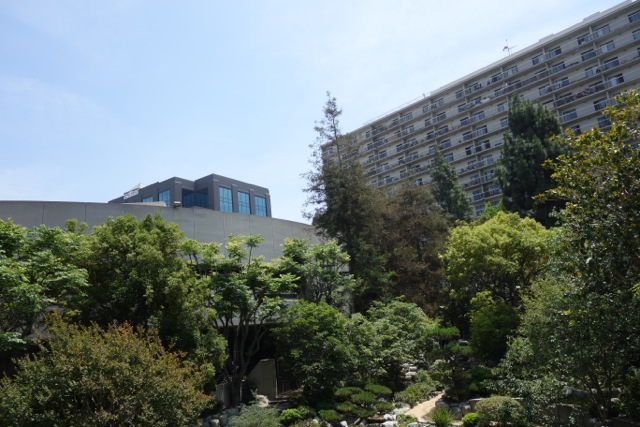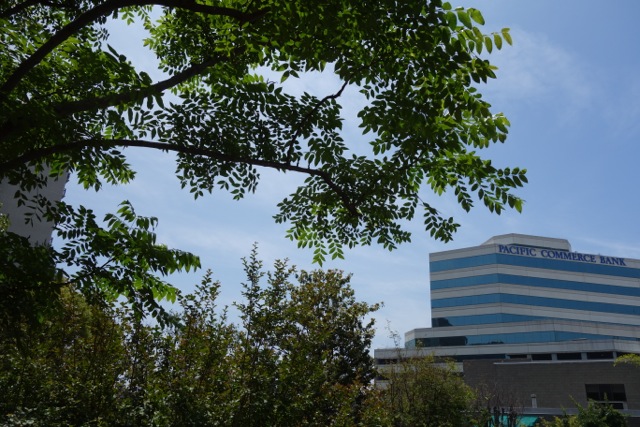
I had lunch not long ago with Geoff Nicholson at Mr. Ramen, Little Tokyo’s finest perpetually reggae-soundtracked noodle shop. He reminded me of the existence of the James Irvine Japanese Garden, a fixture of (and fairly well-known wedding venue at) the Japanese American Cultural and Community Center. Built to the side of the JACCC’s not-particularly-loved gray concrete building (complete with “windswept plaza”) where I take Japanese classes each week and open to the public most days (although not the ones my classes happen on), it counts as one of the many features of downtown Los Angeles that you wouldn’t know about unless you knew about.

Though built below ground level, the James Irvine Japanese Garden garden doesn’t let you forget where you stand. A bank, a senior-housing high-rise, the JACCC’s also-concrete-y Aratani Theater: these and other visible modern structures keep downtown present, no matter how well-curated the east Asian plant life that partially obscures them. And in an urban Japanese garden, I want exactly that: the contrast between timeless botanical virtue and the starker claims of the slightly aging built environment.
By no means do only Japanese gardens pull this off. The low walls of the Lan Su Chinese Garden, located right in downtown Portland, allow in just enough of that city’s often low-rise but nevertheless highly reflective towers that I don’t mind paying its entrance fee. (Portland’s Japanese Garden, while nice enough, sits up in the hills as an escape from the city — not something for which I yearn.) But you can appreciate the Japanese gardens of Little Tokyo at no charge; the James Irvine Garden makes it explicit, while the garden on the third floor of the Doubletree Hotel works that way de facto, if not de jure.
The Doubletree dates from Japan’s property bubble of the 1970s and 80s, which resulted in a great many downtown Los Angeles towers built or bought with Japanese money, and has gone through a few names: when I moved here it was called the Kyoto Grand, and before that the New Otani. Through it all, its garden has remained, and remained accessible: sure, the signs say it’s for guests only, but just walk through the lobby (itself, despite an apparent renovation or two, something of a bubble-era time capsule) like you belong there and take the elevator to the garden level. (I still haven’t figured out which stairway leads there.)
The Doubletree’s vantage offers not just the contrast between garden and city, but between garden, city, and city to come. Newer buildings surround it, some so new that they’re still under construction. Several exemplify the “mixed-use” model, with retail and offices on the bottom and apartments and condos on top, that has finally gained traction here. I fear that the architectural blandness of many of these projects (though not necessarily the ones in Little Tokyo) will one day give mixed-use a bad name, but I still think about living in one of them in my next stint in Los Angeles. Hell, skybridges now have a bad name too, but whenever I visit the Doubletree’s garden, I leave by the one that connects it to the equally 1980s Weller Court; that way, I can go straight to Kinokuniya and browse their issues of Free & Easy. Could any mixed-use building I end up in, no matter how urbanistically sound, offer an amenity like that?


